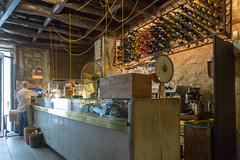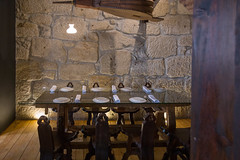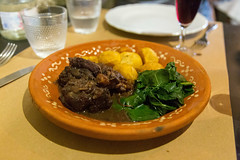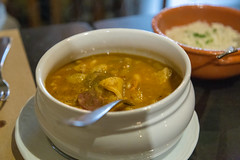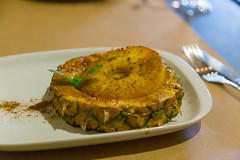On one day of our trip to Porto, we did an outstanding “Vintage Food Tour” from Taste Porto, and our host for that tour, Andre, not only showed us over a half dozen great little culinary spots around Porto, he also made sure to stop and point out some of his favorite gems around the city as we passed by. One place was not on our tour, but on another of Taste Porto’s walking tours, and our host loved it enough that even though we weren’t stopping there, he recommended we make time to get a reservation and come back on our own: Flor dos Congregados.
Flor dos Congregados is the sort of place that’s easy to miss if you don’t know about it. It’s less than a block from Avenida dos Aliados, Porto’s main boulevard, but it’s tucked into a small dead-end alley with unassuming signage in a narrow building that doesn’t look like it is big enough to hold a restaurant. But like a good number of other places we found in Porto, the locals are quite architecturally good at squeezing into odd little spaces, and while distinctly cozy, Flor dos Congregados manages to fit a small wine bar, kitchen, and two dining rooms into a vertically stacked, three-story space.
Flor dos Congregados, which has been around in one form or another for over 160 years, specializes in two things: slow food (focusing on local food and traditional cooking without taking shortcuts or hurrying diners), and local family cuisine. As such, they’ve got quite the menu of traditional dishes including nacos de vitella (literally, “veal chunks”), Alheira (rustic Portuguese sausage), and tripe (long considered a traditional dish of Porto, indeed, the residents of Porto have long been known as “Tripe Eaters”). The menu is constantly changing due to ingredient availability, so the staff brings by a small chalkboard with the current specials, as well as several dishes that are regulars like their “terylene sandwhich and a glass of rosé for 5 euros”).
Starting out, we had a very pleasant marinated mixed mushroom appetizer, and this was a great example of some of the good rustic food we got throughout Portugal: a flavorful mix of mushrooms (mostly chanterelles) in a light white wine vinegar marinade, these were definitely a step above most marinated mushrooms.
Our TastePorto tour guide highly recommended Flor dos Congregados’ terylene, so that’s how we started our main course, with a pair of them. Named for a delicate fabric, it’s actually a pork sandwich made with 24 hour roasted pork, topped with a slice of ham, and then the entire thing is finished in a wood-fired oven. Remember how a few posts ago I was raving about how great the pork sandwiches are at Casa Guedes. These are nominally the same sort of sandwich, but amped up. Between the even more tender pork, some rich ham, and the extra crustiness the entire sandwich gets from the final wood oven roasting? It’s pretty much pork sandwich perfection between tender pork soaking into the bread, some tangy aged ham, and extra crustiness in the roll. The Terylene and rosé combo has got to be a great example of Porto’s local food scene in a nutshell.
Next up, the Nacos de Vitella. Literally “veal chunks”, that’s exactly what this dish is, chunks of veal cooked in a red wine and garlic sauce until falling apart-tender, served up with some braised greens and potatoes. A simple dish conceptually, the long, slow cooking makes this really work: each bite of pork was fork-tender and falling apart, with wine and garlic just permeating the meat.
Then, it was time for tripe. Tripe saddens me a bit since most Americans I know seem to be fearful of it. I’m not really sure why, because prepared well (in the form of Vietnamese phở or Mexican menudo, for example) it is quite a tasty dish, and Portugal (and Porto in particular) have made tripe their local dish for centuries: “Tripas à moda do Porto” (“Tripe, Porto Style”). It’s definitely a delicious dish, much like a French cassoulet, with tripe stewed with white beans in a rich wine sauce, this was a very, very enjoyable dish. If you don’t think you like tripe, you are literally missing out here.
Rounding out the meal was a pair of excellent desserts. I opted for the spice pineapple. Like some of my other travels, like Reunion island, the pineapple in Portugal is subtly different from the Hawaiian pineapples I get at home, since these pineapples are from the Azores, and have a rich flavor that’s a bit sweeter and less tangy than the Hawaiian version, making for a nice little dish when roasted up in some spices. Carol opted for a wine-poached pear, which was as flavorful as it was simple.
Overall, we loved Flor dos Congregados. The food is rustic Portuguese at its best, and the Terylene and wine combo is a phenomenal deal even if you only want a snack. I can see why the place has been around over 150 years, and I’d love a return trip.


